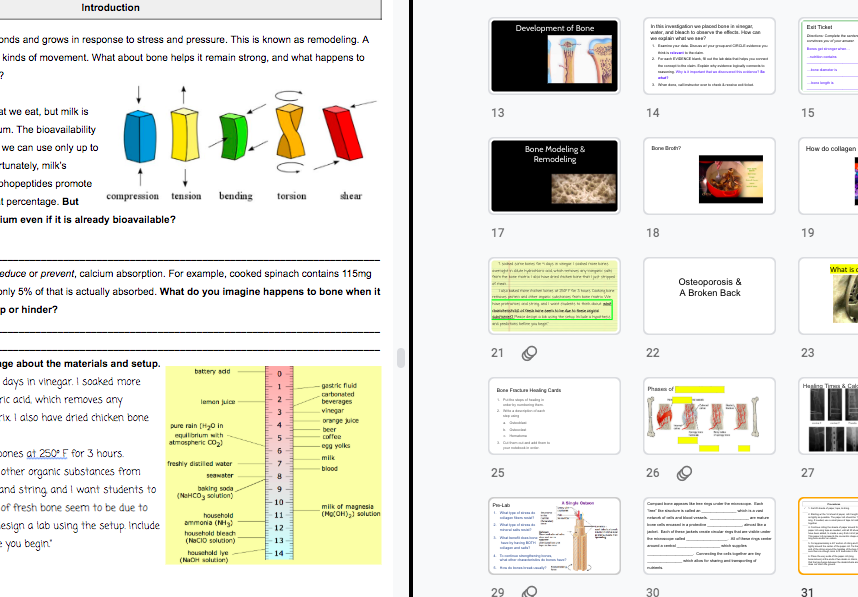Unit (7wk): Musculo-skeletal - Prosthetics
Courses: Physiology, Anatomy, Engineering
I made & taught this physiology unit on musculoskeletal structure & function, via a sequence of inquiry tasks and engineering design challenges, supplemented by vocabulary, readings, videos, gallery walks, and interviews.
Hope the images, videos, & lab worksheets are useful/save time for folks using them! Lessons 3 & 5 need feedback and have poor slides. Some of it has messy highlighting, but I thought I'd share it now given now is a popular time for this subject to be taught. I will keep updating this post with version changes below. (Please supplement with your own reference docs for anatomical terms.)
Includes Do Nows, Exit Ticket, lab writeups, reading w/ checks for understanding, rubrics, and final project workbook.
Open By Lesson
(jump to individual agendas & materials)Open All
in Google Drive
1. Overview [Dissect: Chicken Wing]
Agenda
Do Now - proprioception tasks
Unit Overview
Unit-Long Project: 3D Skull Puzzle by Joshua Harker (video tutorial) (simpler alternative)
Dissection: Chicken Wing (backup link in handouts document)
Notes
Basic Terminology
Disorders
Exit Ticket - Parts of the Skull
2-3. Micro - What happens when muscles get tired? [2 labs]
NEEDS FEEDBACK
2. Agenda
Do Now: Energy & Physical Activity
Modeling: In/Output of Body
Lab: What happens when you take oxygen (O2) out of cellular respiration?
Reading: Cellular Respiration
Alternate Lab if students have prior knowledge of cellular respiration: Skeletal Muscle Fatigue
3. Agenda
Do Now: I/O Cellular Respiration
Lab: What happens when you take carbon dioxide (CO2) out of cellular respiration?
Watch & Discuss: Marathon Runner
CER Letter to Marathon Runner
Exit Ticket: Lactic Acid
Optional extensions:
Temperature of Muscles (student wksht) (lab writeup)
4-5. Can you really build stronger bones by drinking milk? [3 labs]
4. Agenda
Do Now - How much calcium do you eat? (Engage)
Science Media Moment: Do you know how much calcium is in your diet?
Video: Introduction to Bone Biology (Explore)
Turn & Talk: What is bone made of?
Lab: What is bone made of? (Explore)
Reading: Bone Growth (Explain)
Lab: What makes tough bones? (Explore)
Video: Osteoclasts & Osteoblasts (Explain)
Evidence Match: Bone Lab Explanations (Evaluate)
Exit Ticket
5. Agenda
Do Now - Predict Repair & Breakage
Pre-lab Videos (Engage)
Bone Modeling & Remodeling
Bone Broth
Collagen Pills
Lab: What makes tough bones? (Explore)
Reading: Osteoporosis (Explain)
Card Sort: Phases of Healing (Explore)
Video & Talk: Truss construction vs. Spongy bone (Elaborate)
Exit Ticket - Challenges in Bioengineering Materials (Evaluate)
6-9. Macro - Fractures & Interventions [2 labs, 1 engineering challenge, 2 assessments]
6-7. Agenda
Do Now - Interview a Peer About A Broken Bone or Dislocation (Engage)
Video: A Painful Point Break (Explore)
Lab: Fracture (Explore)
Slideshow: Types of Bone Fractures, Healing, & Interventions (Explain)
2 Exit Tickets - Natural Bone Repair & Fracture Characteristics
Assessment
Practice: Assessment case study – DIAGNOSIS? (Elaborate & Evaluate)
Assessment: Case Study – DIAGNOSIS? (Elaborate & Evaluate)
8-9. Agenda
Do Now - Angular & Linear Motion Activities (Engage)
Gallery Walk - Hard or Fast Biter? (Explore)
Jeopardy! Card Match - Review Lever Terminology (Engage)
Engineering Challenge: Build-A-Bicep (Elaborate)
Design Approval & Prototyping
Optional activity: Moveable Joints Charades
Mini-Lab: Musculoskeletal Biomechanics & Levers (Explore)
Reading: What Levers Does Your Body Use?
Class Calculation: Mechanics of Muscle Motion
Testing, Revising, and Marketing Video for Invention
Exit Ticket - Speed v. Force Advantage (Evaluate)
Optional Activities for Reinforcing Concepts:
Levers: This exercise or this excellent and easy set of experiments and calculations from Chicago’s Field Museum.
Baseball Musculoskeletal Biomechanics Lesson Plan: https://docs.google.com/document/d/16QuxrQ9vB6Glix8ywNxv0yQVG_xPFkFy/edit
Extension Experiments
10-18. Final Project: Prosthetics Engineering
10-18. Agenda
Do Now - Activities, Places, Risks for K-12 children
Introduction to Design Engineering - Afghanistan, Land Mines, Mine Kafon
What do these devices resemble? What do they look like? Has anyone had experience with these?
What do we know about the children and culture in Afghanistan?
Videos: Mine Kafon & Mine Kafon 2.0 (Invention, Iteration, & Entrepreneurship)
Mini-Practice: Design Engineering Your Morning Routine
Step: Interview Partner - Connect to the Client (Develop Empathy)
Step: Confirmatory Listening - “I hear you saying…” (Define the Problem)
Step: Prototype - Use recyclables to build a model of something that improves your peer’s morning
Step: Present & Explain
Team Jobs & Agreements
Research - Fact Pages
Lecture: History of Prostheses
Review: Design Engineering Process
Mini-Engineering Challenge: Notecard Tower
Mini-Bioengineering Challenge: Prosthetic Hand
Disability Awareness
Ideas & Prototype Designs
Materials List
2 Ideate prototype designs with Pros & Cons
Iterate: Present to another group for feedback, propose second draft design
Create marketing plan and poster
Rehearse presentations
Design Showcase for Inventions
What makes a good showcase?
Feedback and Reflection Forms
Sources
Comparative skeletal anatomy of vertebra of several apes, from https://askabiologist.asu.edu/sites/default/files/assets/stories/EvMedEdits/Osteoporosis/bone_comparison_2.jpg
Ask a Biologist, Healing Bone Worksheet. Retrieved from https://askabiologist.asu.edu/sites/default/files/resources/coloring_pages/pdf/aab_healing_bone_worksheet.pdf
Andrew Burchill. (2017, June 06). Evolution Detective: The Case of the Broken Bones. ASU - Ask A Biologist. Retrieved August 26, 2019 from https://askabiologist.asu.edu/evmed-edit/evolution-osteoporosis
Meghan M. Cotter, David A. Loomis, Scott W. Simpson, Bruce Latimer, Christopher J. Hernandez. Human Evolution and Osteoporosis-Related Spinal Fractures. PLOS ONE. Published: October 19, 2011. Retrieved from https://doi.org/10.1371/journal.pone.0026658.
University of Missouri-Columbia. (2008, July 30). Accelerated Bone Turnover Remains After Weight Loss. ScienceDaily. Retrieved September 3, 2019 from www.sciencedaily.com/releases/2008/07/080728193227.htm
the Arizona Science Center. (2011, May 13). Broken Bones. ASU - Ask A Biologist. Retrieved September 3, 2019 from https://askabiologist.asu.edu/how-bone-breaks
BC Campus Open Textbook. 6.5 Fractures: Bone Repair. https://opentextbc.ca/anatomyandphysiology/chapter/6-5-fractures-bone-repair/
Minnesota Science Teachers Education Project, Levers: How the Human Body Uses Them To Its Advantage. https://serc.carleton.edu/sp/mnstep/activities/humanlevers.html.
Biomechanical Principles of Levers. https://humankinetics.com/AcuCustom/Sitename/DAM/167/PDF_sample_34-37.pdf
Field Museum Education Department, The Machine Inside: Biomechanics Activity Guide - Advantages of Levers. https://www.fieldmuseum.org/sites/default/files/bioguide-levers_0.pdf






